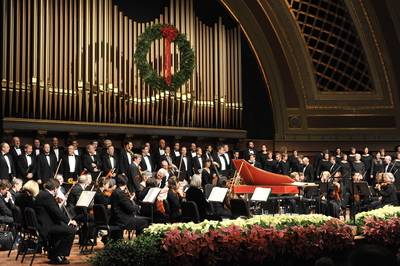One of Ann Arbor's longest-standing traditions returning with Handel's 'Messiah'

"Messiah" returns to Hill Auditorium this weekend.
They’re all Ann Arbor traditions.
But for longevity, they can’t hold a candle to the Choral Union’s annual performances of Handel’s “Messiah.” Come Saturday and Sunday, the Choral Union—which spawned the University Musical Society (now its parent organization) with its initial performance, in 1879—offers “Messiah” for the 133rd year running. Of course, the organization, directed since 2004 by Jerry Blackstone, has sung many more “Messiahs” than its years indicate; multiple performances—three annually in the more distant past, now two—give it an exceptional handle on Handel.
The same is true for Blackstone (life total “Messiahs,” counting this year’s: “around 25,” he said). And it’s true as well for the “Messiah” orchestra of record, the Ann Arbor Symphony; for harpsichordist Edward Parmentier; for organist Scott VanOrnum; and for the four vocal soloists, three of whom (soprano Mary Wilson, tenor Colin Balzer and baritone Joshua Hopkins) are not just “Messiah” veterans, but Ann Arbor-Hill Auditorium “Messiah” veterans. Mezzo Meg Bragle, a University of Michigan aluma active in early music, makes her UMS “Messiah” debut.
With “Messiah,” the music is so wonderful that familiarity seems to breed content.
PREVIEW
Handel's "Messiah"
- Who: The UMS Choral Union, Jerry Blackstone, conductor; with the Ann Arbor Symphony Orchestra; Edward Parmentier, harpsichord; Scott VanOrnum, organ; and vocal soloists.
- What: Annual return of one of Ann Arbor's longest-held traditions. Also, the Pioneer High School String Quartet plays seasonal favorites in the Hill Auditorium lobby before the show and during intermission. “Messiah” ticket required.
- Where: Hill Auditorium, 825 N. University Ave.
- When: Saturday, 8 p.m.; Sunday, 2 p.m.
- How much: $10-$36. Tickets available from the UMS League Ticket Office, 734-764-2538, and online at ums.org.
- Related event: Sunday, Dec. 4, 5:15 p.m.: Baird Carillon 75th Anniversary Celebration, Burton Memorial Tower. Free. University Carillonneur Steven Ball re-creates the 1936 dedicatory recital in celebration of the 75th anniversary of the newly restored instrument's installation.
One of the things that makes “Messiah” special for Blackstone is the crew of soloists, he said.
“The synergy that happens among them, and with me and with the chorus, colors the whole performance -- how the chorus responds, how the orchestra responds,” Blackstone said. “Three of the soloists this year have sung “Messiah” with me before, and Meg Bragle is an old friend - she and I worked at Interlochen together—and she and Mary (Wilson) are the dearest of friends. So we have a good time, and everybody is really comfortable. From Thursday through Sunday, it’s a bit of a party.”
And of course, it’s a party the audience gets to participate in, rising to join the Choral Union for the “Hallelujah” chorus.
The party has a post-party this year, occasioned by the celebration of 75th anniversary: three-quarters of a century ago, to the day, on Dec. 4, 1936, the Baird Carillon, in Burton Memorial Tower, was dedicated and head for the first time.
To mark the occasion, at 5:15 p.m. Sunday, following “Messiah,” University Carillonneur Steven Ball re-creates the 1936 dedicatory recital.
The bells of the Baird Carilllon have been silent since April 2010, except for a brief two-day period in June 2011 when they sang out during a carillon conference. The reason was a major restoration of the instrument, undertaken under Ball’s direction. Ball is a specialist in the field of campanology, and a professor of organ and carillon at the School of Music, Theatre & Dance.
The carillon was donated by Charles Baird, a U-M graduate and former athletic director.
As a campanologist, Ball recognized the absolutely unique historical significance and irreplaceable musical quality of these original bells, installed in 1936, but placed in a 1974 renovation—and almost sent to the scrap yard before Ball rescued them. The original bells have now been restored and reinstalled, along with the original keyboard and all new clappers, designed and fabricated according to the original patterns and promising to produce a sound that has been described as “dark and smoky.” The largest bell weighs 12 tons and strikes the hour; the smallest bell weighs 16.5 pounds.
Recent research revealed that the instrument was revolutionary in numerous ways: the first use of ball-bearing transmission, the heaviest ever cast by John Taylor & Co. Bellfoundry in Loughborough, England in 1936, the first to use "B" crooks and, one of the first carillons to be built in the United States, and, of course, the principal teaching, and performance instrument of the oldest program for the study of carillon and campanology in the nation.
If tradition rules the stage at “Messiah,” it does so doubly on Sunday, when the concert is part of a real Ann Arbor double-header. Just remember warm gear for the outdoor portion of the festivities.

